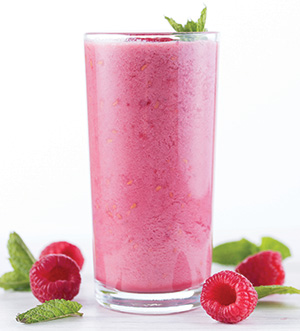While trendy, there are two sides to the story. Ethan Baldridge, MS, RDN, LDN, Clinical Nutrition Manager at Aiken Regional, shares his insight.
 Juicing and making smoothies has gained in popularity in recent years, both touted for being healthy because they include fruits and vegetables. And while they are nutritious, it is often how they are prepared that makes a difference. “The gold standard with fruits and vegetables is to consume them in their natural state. You get both the micro and macro nutrients at once,” says Baldridge. “It is also easiest for the body to digest.”
Juicing and making smoothies has gained in popularity in recent years, both touted for being healthy because they include fruits and vegetables. And while they are nutritious, it is often how they are prepared that makes a difference. “The gold standard with fruits and vegetables is to consume them in their natural state. You get both the micro and macro nutrients at once,” says Baldridge. “It is also easiest for the body to digest.”
The Pros and Cons
One benefit to juicing or drinking a fruit and/or vegetable smoothie is that it is a quick and easy way to enjoy your chosen produce and the vitamins and minerals they provide.
However, you lose vital components of the fruits and vegetables. “Smoothie makers and juicers can degrade the quality of the food because they break down the bioavailability of the nutrients, fiber, fat and cell structure,” says Baldridge. “Satiety is also lower because the natural fiber in the fruits and vegetables is broken down. If you use a juicer, the fiber content is left behind, and with that, all of the coenzymes and other factors that help with digestion.”
With smoothies, you have a lot of flexibility, especially when using frozen fruit. A down side, Baldridge cautions, is the amount one smoothie makes. “You really need to be aware of portion size, as many smoothie recipes are for more than one serving. If you are not sharing the smoothie, cut the recipe in half,” he says. “Don’t make the whole recipe and put some aside for later, as the enzymes start breaking down and the nutritional quality suffers. It is also best to consume your smoothie or juice right away.”
Tips for Diabetics

If you have diabetes, be sure to count your sugars and carbohydrates. Baldridge advises that there is a certain range of carbohydrates that is appropriate for each meal. “We encourage diabetics to use fruits with lower sugar, such as blueberries and strawberries. A measured portion in a smoothie is fine,” he says. “We strongly encourage using fresh or frozen fruits, and avoiding canned or jarred fruits that contain added sugar or high-fructose corn syrup.” Fruit juice is only recommended if a patient is at risk for diabetic shock, Baldridge adds.
Baldridge recommends buying fruits and vegetables in season and local to you. “Flash frozen is more beneficial than something imported, as they are ripened with gas, not naturally,” he says. “Do the best you can to get the most nutritional value.”
